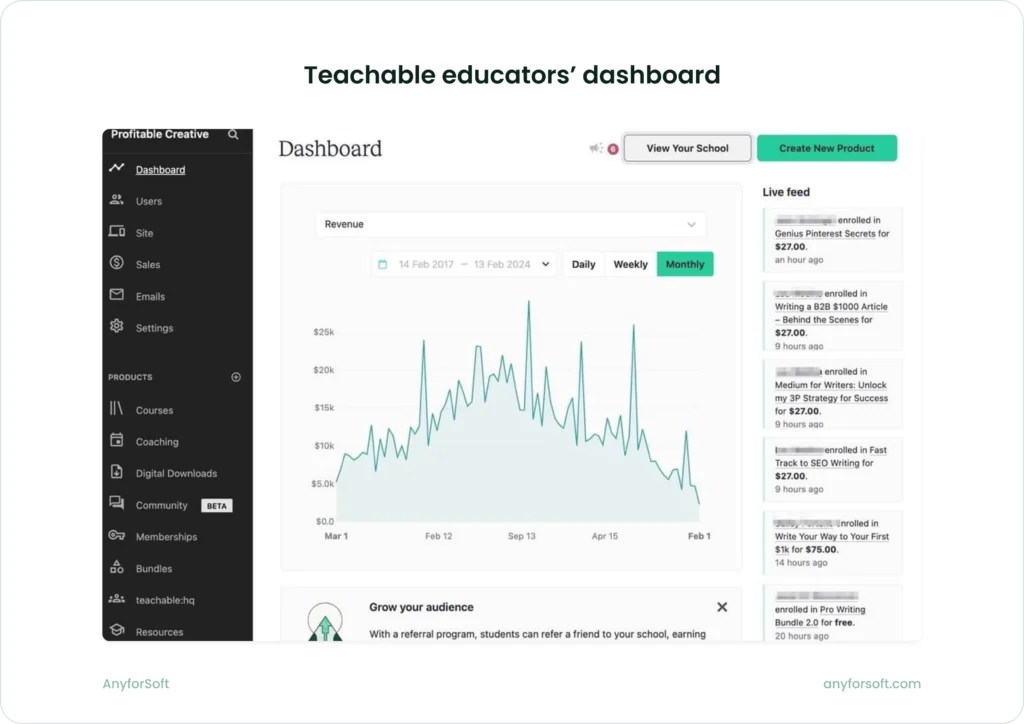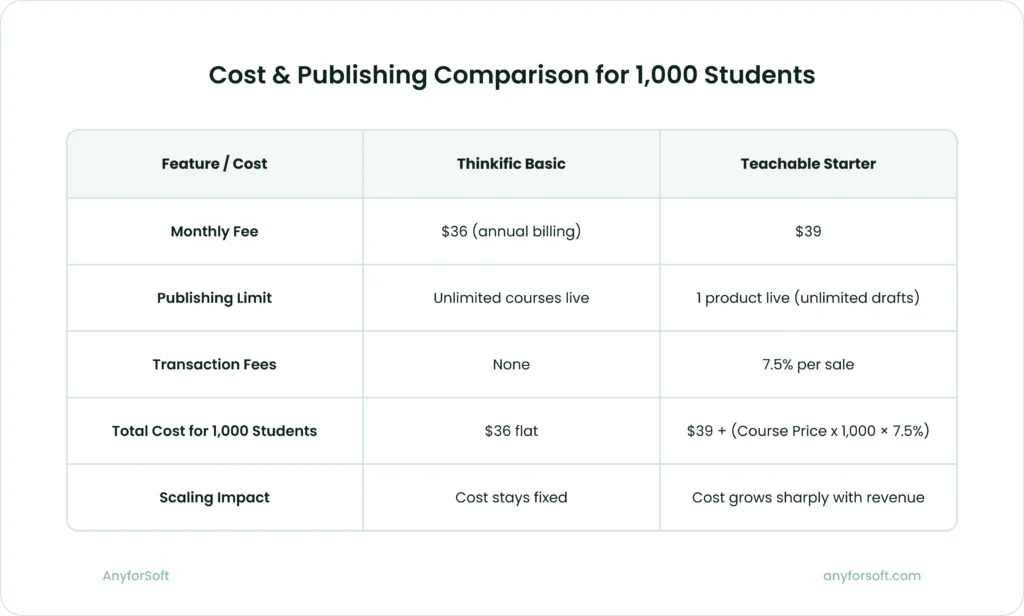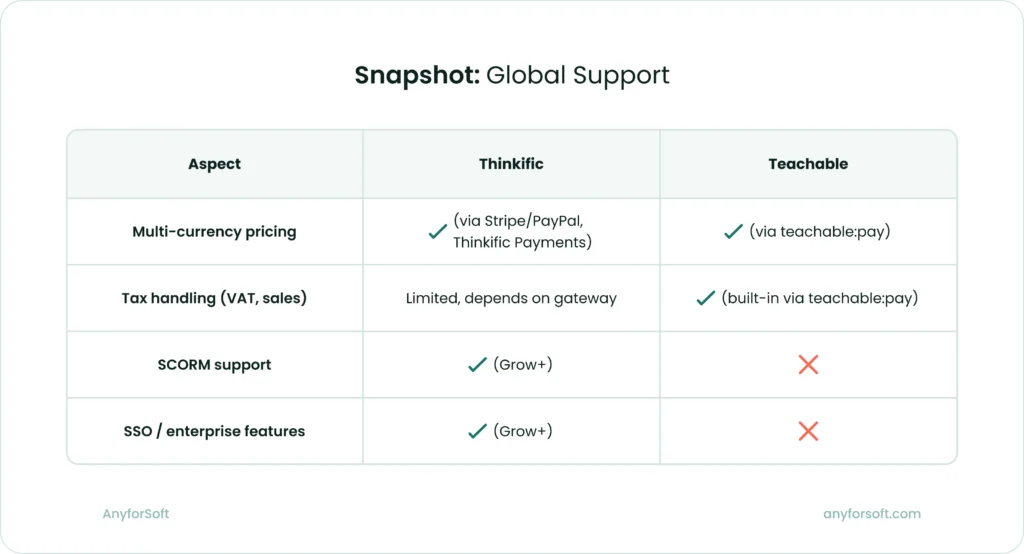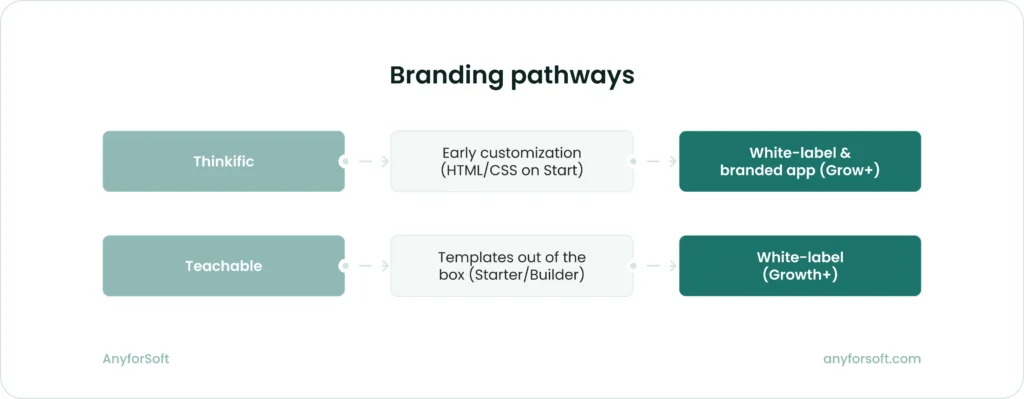You’ve narrowed your decision to two dominant platforms: Thinkific vs Teachable. Yet, the standard feature checklists rarely provide clarity; instead, they often generate more uncertainty.
Beyond polished marketing claims, you’re left asking yourself:
- Which platform will truly advance your revenue ambitions?
- What hidden costs may surface as your business grows?
- Will technical limitations create integration bottlenecks that force costly workarounds?
The answers can define both your profitability and your long-term scalability.
Drawing on 14+ years of experience in building tailored e-learning platforms, and designing specialized tools for education businesses, the AnyforSoft team has seen firsthand how platform choices influence growth. As an education software development company, we move past surface comparisons and explore what truly matters for course creators making a pivotal decision.
So rather than stopping at the Thinkific or Teachable features, let’s go deeper.
We’ll evaluate how each platform impacts your costs, integrations, and scalability, and reveal the implications that go far beyond first impressions.
Head-to-Head Platform Analysis
Both Thinkific and Teachable lead the online learning market, but they solve the same challenges in different ways. Let’s look at these peculiarities through the lenses of features and figures.
Core functionality comparison
At first glance, both platforms promise intuitive drag-and-drop course creation, seamless payment processing, student engagement tools, and comprehensive analytics. Yet under closer inspection, their approaches branch into two distinct paths.
Key feature trends:
- Course creation: Thinkific emphasizes deep customization of learning experiences and site design. It’s ensured by advanced course structuring, comprehensive analytics dashboards, and extensive theme options. Teachable prioritizes streamlined creation and quick deployment through intuitive drag-and-drop builders that let creators launch courses in minutes.
- AI-based tools. Both platforms use AI to streamline essential course creation tasks, including generating course outlines and creating quizzes. Teachable‘s AI Course Starter stands out by drafting a complete curriculum, lesson content, and sales pages in a single workflow — a reflection of how AI in EdTech is redefining course creation efficiency.
- Mobile access: Both platforms provide mobile apps for both iOS and Android OS.
- Marketing tools. Teachable provides comprehensive built-in marketing features including abandoned cart recovery, affiliate management, and conversion-focused tools like upsells and referrals. Thinkific offers foundational email automation but emphasizes flexibility through extensive third-party integrations, connecting with 90+ marketing tools via its App Store and Zapier.
- Student engagement: Teachable appeals with a user-friendly interface, integrated marketing tools, and a mobile app option, though its engagement tools remain simpler. While both platforms provide quizzes, certificates, and forums, Thinkific enriches the learning journey through live sessions and digital downloads that expand student interaction.
This Teachable vs Thinkific analysis shows Teachable emphasizing simplicity and speed, while Thinkific focuses on customization and structure.


Pricing reality check
When looking at Teachable vs Thinkific pricing, the main difference lies in transaction fees and publishing limits. Thinkific lets you publish unlimited courses with no extra fees, while Teachable allows only one published product on the Starter plan and adds a 7.5% transaction fee.
The Thinkific plan for a “pro” level, named Thinkific Plus, is designed for high-growth businesses and provides dedicated onboarding and customer support with custom enterprise solutions, making it ideal for teams that need tailored implementation and ongoing assistance to scale their online learning business.

Thinkific Basic is predictable and scales affordably; Teachable Starter can become expensive fast once you grow beyond a very small student base.
Integration and customization capabilities
Both platforms offer third-party app integration; however, there are differences in accessibility.
- Integrations. Thinkific integrations extend platform functionality through hundreds of third-party applications available via the native Thinkific App Store or automation services like Zapier and Make. Key integrations include marketing tools, e-commerce platforms, and student engagement features. Teachable unlocks API & Webhooks starting from Growth, while Starter and Builder don’t include them. Integrations are available through the app marketplace, but Starter does not list direct API access.
- Branding and customization. Both platforms require upgrades to remove branding. Thinkific gives more flexibility earlier, with HTML & CSS editing available on the Start plan, while Teachable reserves white-labeling and deeper branding options for Growth and Advanced tiers.

The takeaway of this in-depth Teachable vs Thinkific comparison is as follows: Thinkific introduces customization sooner, while Teachable keeps it simpler but pushes full control higher up the pricing ladder.
Platform reliability and market position
While they share many similarities, both platforms have a few notable differences in market position and long-term viability.
Client reach provides the first signal of divergence. Teachable reports around 30,000 active stores as of Q1 2025. Thinkific, on the other hand, serves more than 50,000 active customers.
Here are some finance-related figures. Thinkific reported $66.9 million in revenue for 2024, and a 73 percent increase in Commerce revenue, as stated in its official financial results.
Here is an outcome that Teachable can be proud of, in turn. In 2024, the platform and its parent company Hotmart collectively reached a significant milestone, with creators across both platforms generating $10 billion in total earnings.
What about industry recognition? Thinkific earned awards in three categories of G2’s 2025 Best Software Awards, including Education and Customer Service. It also received TrustRadius’s 2025 Top Rated Award, which is based on authentic user reviews. These achievements highlight reliability and user satisfaction as Thinkific’s main strengths — qualities you would also expect from an education portal development company delivering enterprise-grade solutions.
Teachable’s recognition centers, in particular, on the performance of its mobile app, which holds a 4.6 out of 5 rating, according to 8,800 reviews.
If Thinkific represents excellence in reliability and service, Teachable stands out for user experience design and learner engagement.
User sentiment completes the 2025 Thinkific vs Teachable comparison. Recent reviews on Clutch describe Thinkific users valuing comprehensive features and the benefit of zero transaction fees, though they also warn that complexity may slow down beginners.
Teachable users consistently highlight the platform’s simplicity and ease of launch, yet many express concern about scaling costs and limited customization.
The overall picture becomes clear:
- Thinkific: Better suited for long-term growth, though more complex in the beginning.
- Teachable: Easier for initial launches, though more expensive as you expand.
The Selection Algorithm: 6-Step Decision Framework
When creators compare platforms, they often drown in endless feature lists. Instead of asking which platform has more checkmarks, you should apply a structured algorithm that matches platform capabilities with your specific business needs. This method clarifies the decision in a way feature charts never can.
Step 1: Assess your technical comfort level
If you prefer a plug-and-play solution with minimal decisions, Teachable is the safer choice. If you enjoy configuring options and seek full control, the Thinkific benefit is the flexibility you require.
Step 2: Calculate your true budget
For businesses under $1,000 per month in revenue, Thinkific’s zero transaction fees produce clear savings. As revenue grows, compare Teachable’s higher tiers against Thinkific’s predictable subscription fees.
Step 3: Define your integration needs
On both platforms, advanced integrations are gated behind higher-tier plans. Teachable unlocks API and Webhooks at the Growth plan, while Starter and Builder do not include direct API access. Thinkific also reserves advanced integrations, such as CRM, API, SCORM, and SSO, for its Grow plan and above.
Step 4: Determine your customization requirements
If maintaining brand consistency matters early, Thinkific offers HTML & CSS editing from the Start plan and removes its branding at the Grow level. If you’re fine with ready-to-use templates and prefer simplicity over deep customization, Teachable provides polished designs out of the box but holds white-labeling for Growth and Advanced plans.
Step 5: Match your business model to platform strengths
If you run multiple courses, design complex learning paths, or plan for predictable scaling, Thinkific aligns with your strategy. If you test single courses, launch quickly, and rely heavily on built-in marketing automation, Teachable is the better match.
Step 6. Consider custom development
Both platforms succeed within their designed boundaries. If you remain within those boundaries, you will be satisfied.
However, as your business evolves, you may encounter compliance requirements, complex workflows, or integration demands that neither platform addresses fully. At that stage, custom development becomes the natural step to ensure your platform adapts to your unique vision rather than forcing your vision to adapt to platform limits.
Scenario-Based Recommendations
Beyond general “Which is better, Teachable vs Thinkific?” comparisons, it makes sense to ask how each platform performs in specific business situations. The following scenarios illustrate real-world contexts that clarify which choice supports your unique needs.
1. For complete beginners: First-time course creators
If you are entering the online course space for the first time, your priorities include quick setup, clarity, and minimal technical barriers. Teachable meets these conditions by emphasizing simplicity. Its intuitive interface allows you to move from concept to published course without advanced skills. Its pre-designed templates ensure a professional appearance even if you never touch customization settings.
The financial structure also helps beginners. With lower upfront subscription costs and a transaction-fee model, you can test your course idea without a large commitment. If you succeed, costs rise, but at the beginning, the risk remains low.
Key advantages include faster time-to-market, built-in payment processing, and a user-friendly builder. The challenges include growing transaction fees, limited customization once you begin to develop brand preferences, and support that may feel slow at lower tiers.
2. For marketing-heavy creators: Content marketers and influencers
If marketing funnels, email automation, and promotional campaigns define your success, Teachable provides stronger built-in support. It offers affiliate program management, upsell opportunities, and coupon code creation without requiring additional integrations. The limitations appear when you demand advanced integration with specialized marketing stacks.
If your strategy involves tools like HubSpot or Salesforce with custom workflows, Thinkific may fit better because it integrates deeply through Zapier and APIs (starting at the Grow plan). Teams relying on advanced e-learning software development services can extend these capabilities with custom add-ons.
3. For high-volume sellers: Established course businesses
If your business generates substantial monthly revenue, transaction fees quickly become a burden. At $1,000 per month, Teachable’s Starter plan costs more than Thinkific’s Basic plan once fees are calculated. At $5,000 per month, the difference widens dramatically.
For this scenario, Thinkific is the stronger choice. It offers unlimited courses, enterprise-grade analytics, and predictable subscription pricing without transaction fees. High-volume creators save hundreds or even thousands of dollars annually by avoiding percentage-based charges.
Key advantages include unlimited scalability, comprehensive reporting, and enterprise readiness. If you value predictable costs above early simplicity, Thinkific provides the advantage.
4. For brand-conscious businesses: Companies with strong brand identity
Thinkific offers greater customization. It supports advanced theme modification and offers a Branded Mobile App add-on on higher tiers, while standard plans include generic mobile access.
Teachable, although it provides some white-labeling on higher plans, does not match Thinkific’s flexibility.
5. For corporate trainers: B2B and enterprise training programs
If you design training for organizations, compliance, reporting, and user management become priorities. Thinkific aligns with this scenario by offering SCORM compliance, advanced analytics, and enterprise-grade features such as detailed user management. These tools support corporate clients who require proof of progress, compliance certificates, or hierarchical structures for large teams.
Teachable can serve smaller B2B use cases, but its focus remains individual creators, not enterprise demands.
6. For coaches and consultants: Service-based business models
If your model combines courses with coaching, Teachable offers a product designed specifically for you. Its coaching tool includes intake forms, scheduling integrations, and client management features. You can merge course delivery with one-on-one coaching inside the same platform.
The key advantages are dedicated coaching tools, scheduling integrations, and streamlined service delivery. For this scenario, Teachable is clearly optimized, while Thinkific requires external integrations to achieve similar functionality. Relying on an EdTech app development guide, coaches select the right ecosystem of tools.
7. For membership site operators: Recurring revenue models
If your strategy relies on memberships, the decision depends on complexity. For simple recurring content, Teachable’s built-in membership tools provide convenience. For community-driven memberships with advanced interaction needs, Thinkific offers stronger options with forums, analytics, and customization.
The decision point is straightforward: choose Teachable for simplicity, choose Thinkific for community-driven depth.
8. For international creators: Global market focus
If your business serves global audiences, payment flexibility becomes decisive. Teachable offers built-in multi-currency pricing, regional tax handling through teachable:pay (Teachable‘s native payment gateway), and clearly published fee schedules. Thinkific supports international payments, as well, but availability and rates depend on the country and gateway.
Future-Proofing Your Choice — Which Platform Scales with You?
Choosing between Thinkific and Teachable isn’t only about what works today. The real challenge comes when your business grows, new technologies emerge, and your platform must adapt. In the future of education technology, success will depend on automation, integrations, global readiness, and compliance. Thinkific and Teachable take different paths toward these goals, and those differences matter when you’re planning not just for launch but for long-term growth.
AI and automation
Artificial intelligence is shaping how courses are created and delivered, and each platform applies it differently.
Teachable has taken the more ambitious path. Its AI Course Starter can assemble an entire foundation:
- a structured curriculum,
- lesson content,
- and matching sales pages.
For individual creators or small teams, this all-in-one automation can shrink weeks of work into a single workflow. The emphasis is on speed, helping beginners launch quickly with minimal manual input.
Thinkific has chosen a more measured rollout. Its AI features currently support quiz generation and course outlines, easing repetitive tasks while leaving overall design choices to the creator. Thanks to integrations with dozens of third-party apps and Zapier, Thinkific can also connect to external AI tools.
Teachable’s approach favors built-in automation, while Thinkific provides a flexible base for those who prefer to combine AI with external systems as their needs evolve.
Scalability and growth
Launching a course is only the first step. The real challenge comes when your audience grows, your catalogue expands, and costs start to accumulate. Thinkific and Teachable address this stage in different ways.
Thinkific allows creators to publish unlimited courses, even on entry-level plans. Combined with the absence of transaction fees when using Thinkific Payments, this gives businesses a predictable cost structure from the beginning. As you move into higher tiers like Grow or Plus, the platform unlocks enterprise-oriented features such as CRM integrations, SCORM compliance, and SSO, which support training at scale. For established course businesses or corporate trainers, this structure creates room to expand without unpredictable expenses.
Teachable, on the other hand, lowers the barrier for early entry but introduces limitations as you grow. The Starter plan restricts you to a single published product and adds a 7.5% transaction fee. For creators testing a single course idea, this model works, since the upfront subscription cost is low. But as revenue increases and additional products are added, transaction fees and tier upgrades quickly drive up expenses. Growth and Advanced plans open more flexibility, but scaling remains more expensive compared to Thinkific.
In practice, Thinkific is structured for long-term expansion, while Teachable works best for those who prioritize a low-commitment start and are willing to pay more as their business matures.
Integration ecosystem
No platform can anticipate every tool a creator might need. The ability to connect with external systems is what determines whether the platform can adapt as your operations grow more complex.
Thinkific invests heavily in connectivity. Through its app marketplace, it offers more than 90 integrations, ranging from marketing tools to analytics and CRM systems. Zapier extends this reach even further, and API access becomes available from the Grow plan onward. This means that as new EdTech tools emerge, Thinkific users have the flexibility to plug them in without replacing the entire platform.
Teachable takes a more contained approach. While it offers a marketplace of integrations, API and Webhooks are reserved for the Growth plan and above. The platform’s philosophy favors built-in marketing and automation features, reducing the need for external tools at the start but leaving fewer options for businesses that depend on specialized systems.
| Capability | Thinkific | Teachable |
| App Marketplace | 90+ apps | Limited set of apps |
| Zapier | Yes (all plans) | Yes (all plans) |
| API Access | From Grow plan | From Growth plan |
| Webhooks | From Grow plan | From Growth plan |
Thinkific positions itself as the integration-friendly choice for creators who expect their technology stack to evolve, while Teachable appeals to those who prefer an all-in-one environment with fewer decisions to make.
Global reach and compliance
Expanding a course business often means serving students across borders, which puts payment flexibility and compliance features into focus. Both Thinkific and Teachable provide international support, but their approaches differ in scope and depth.
- Payments and currencies. Teachable enables multi-currency pricing and tax handling through its native teachable:pay, which simplifies checkout for creators selling globally. Thinkific also supports international transactions via Thinkific Payments or third-party gateways like Stripe and PayPal, though availability depends on the country and gateway.
- Regulatory compliance. Thinkific includes SCORM support and enterprise features such as single sign-on (SSO) and advanced user management at higher tiers, aligning with corporate and B2B training requirements. Teachable remains more creator-focused, covering basic compliance but not extending into SCORM or enterprise-grade structures.

According to HolonIQ’s Global EdTech Market report (2025), internationalization is one of the top three drivers of growth for digital learning providers. Hence, compliance and flexible payments become essential when scaling beyond a domestic audience.
Customization and branding
A strong brand identity helps course creators stand out, and this is where Thinkific and Teachable take noticeably different paths.
- Thinkific opens the door to deeper control early. Even the Start plan allows HTML and CSS editing, giving creators the ability to adjust site layouts, themes, and styles. At higher tiers, Thinkific supports full white-labeling and advanced branding, including the option of a branded mobile app.
- Teachable focuses on polished, ready-made templates that look professional out of the box. This approach benefits creators who value speed and simplicity. However, full white-labeling and removal of Teachable branding appear only at the Growth and Advanced tiers.
- Branding pathways [Visualization]

Ultimately, Thinkific favors flexibility for those who want to shape every visual detail, while Teachable prioritizes simplicity until the creator is ready to invest in higher-tier plans.
Engagement and community tools
Keeping learners active is just as important as attracting them. Both platforms include basic tools like quizzes, certificates, and course discussions, but their emphasis differs.
- Thinkific expands engagement with live sessions, assignments, and digital downloads, which encourage deeper interaction and let creators design richer learning paths. Its community features (forums and memberships) give flexibility to build peer-to-peer connections around content.
- Teachable emphasizes usability. Its interface makes it easy for students to follow lessons and complete quizzes, and its mobile app ensures learning on the go. While engagement features are simpler, the platform integrates them tightly with its built-in marketing tools, linking learning activity with sales and retention strategies.
Both platforms provide the essentials, but Thinkific broadens engagement with additional learning formats. Teachable, in turn, ties participation more closely to marketing and retention.
Platform Recommendation Scorecard
The total scores are close, highlighting that superiority depends on your context, not raw numbers. This Thinkific vs Teachable comparison helps clarify which platform fits specific goals.
Platform recommendation scorecard
| Scenario | Thinkific | Teachable |
| 1. Complete Beginners | 2/5 | 5/5 |
| 2. Marketing-Heavy Creators | 3/5 | 5/5 |
| 3. High-Volume Sellers | 5/5 | 2/5 |
| 4. Brand-Conscious Businesses | 5/5 | 3/5 |
| 5. Corporate Trainers | 5/5 | 3/5 |
| 6. Coaches & Consultants | 3/5 | 5/5 |
| 7. Membership Sites | 4/5 | 4/5 |
| 8. International Creators | 4/5 | 3/5 |
| 9. Scalability potential | 5/5 | 3/5 |
| TOTAL SCORE | 37/45 | 33/45 |
Final Verdict: Making Your Decision
After reviewing functionality, pricing, integrations, reliability, and scenarios, this Teachable vs Thinkific comparison confirms that both platforms can build a successful course business. The decision comes down to alignment.
- Choose Thinkific for zero transaction fees, strong customization, and predictable scaling.
- Choose Teachable for quick launches, beginner simplicity, and integrated marketing tools.
If you prioritize flexibility and branding, Thinkific fits best. If you prioritize speed and automation, Teachable feels natural.
Remember that Thinkific may feel overwhelming for beginners, and Teachable may feel expensive at scale. Thinkific offers stronger scalability potential for long-term growth, while Teachable provides a smoother start but may require adjustments as you expand.
Both paths involve trade-offs, and the correct choice reflects your growth vision for the next 12 to 18 months rather than only your current needs.
At the same time, both are powerful platforms within their boundaries. Some organizations, however, eventually discover that unique workflows, compliance requirements, or team-specific processes call for capabilities beyond what standard systems provide. In such cases, custom platform development becomes an opportunity to extend functionality in ways that perfectly match business needs.
FAQs
Teachable leads for beginners. Its interface removes technical complexity, its templates look professional immediately, and its payment system works without integrations. You can publish your first course quickly. The limitations include higher costs at scale, reduced customization, and weaker support on lower tiers.
Yes, but migration requires planning and effort. You must export content and transfer students, which may take two to four weeks for an established course library.
Mobile access dramatically increases engagement. Teachable’s iOS app doubles return rates and triples completion rates. Thinkific provides generic mobile apps on all plans and branded apps on advanced plans. If your students are professionals or global learners, mobile access is essential.
Thinkific provides stronger international support with broader gateways and better multi-currency handling. Teachable works internationally but has more restrictions in specific regions.
Both platforms offer white-label options, but Thinkific provides them earlier and with more control. Teachable reserves full branding removal for higher tiers, and even then, some limitations remain.
This depends on your strategy. Teachable excels at built-in marketing: affiliate programs, upsells, and automated emails. Thinkific provides basic marketing but integrates deeply with external marketing tools such as MailChimp or ConvertKit. If you want everything in one system, choose Teachable. If you prefer specialized third-party tools, choose Thinkific.
Both scale reasonably, but neither handles advanced enterprise demands indefinitely. If you need complex compliance, custom workflows, or innovative delivery models, you may require a custom-built platform that adapts to your evolving requirements.
Yes. Both platforms charge payment processing fees, but the details differ. On Teachable, the Starter plan adds a 7.5% transaction fee on top of payment processing. Processing rates are 2.9% + $0.30 for U.S. card sales, 3.9% + $0.30 for international card sales, and PayPal payments are charged at PayPal’s standard rates (3.49% + $0.49 U.S., 4.99% + $0.49 international). Thinkific does not charge a platform transaction fee when using its built-in Thinkific Payments, but if you use third-party gateways like Stripe or PayPal, an additional Third-Party Payment Gateway Fee applies.
In that case, custom development often provides better long-term value. A custom platform can integrate seamlessly with your systems, address compliance requirements, and scale with your business without forcing compromises. Many successful course businesses eventually discover this path as they mature.








